Abstract
When cells of the anaerobic thermophile Clostridium thermoaceticum grow in batch culture and homoferment glucose to acetic acid, the pH of the medium decreases until growth and then acid production cease, at about pH 5. We postulated that the end product of fermentation limits growth by acting as an uncoupling agent. Thus, when the pH of the medium is low, the cytoplasm of the cells becomes acidified below a tolerable pH. We have therefore measured the internal pH of growing cells and compared these values with those of nongrowing cells incubated in the absence of acetic acid. Growing cells maintained an interior about 0.6 pH units more alkaline than the exterior throughout most of batch growth (i.e., ΔpH = 0.6). We also measured the transmembrane electrical potential (ΔΨ), which decreased from 140 mV at pH 7 at the beginning of growth to 80 mV when the medium had reached pH 5. The proton motive force, therefore, was 155 mV at pH 7, decreasing to 120 mV at pH 5. When further fermentation acidified the medium below pH 5, both the ΔpH and the ΔΨ collapsed, indicating that these cells require an internal pH of at least 5.5 to 5.7. Cells harvested from stationary phase and suspended in citrate-phosphate buffer maintained a ΔpH of 1.5 at external pH 5.0. This ΔpH was dissipated by acetic acid (at the concentrations found in the growth medium) and other weak organic acids, as well as by ionophores and inhibitors of glycolysis and of the H+-ATPase. Nongrowing cells had a ΔΨ which ranged from about 116 mV at external pH 7 to about 55 mV at external pH 5 and which also was sensitive to ionophores. Since acetic acid, in its un-ionized form, diffuses passively across the cytoplasmic membrane, it effectively renders the membrane permeable to protons. It therefore seems unlikely that mutations at one or a few loci would result in C. thermoaceticum cells significantly more acetic acid tolerant than their parental type.
Full text
PDF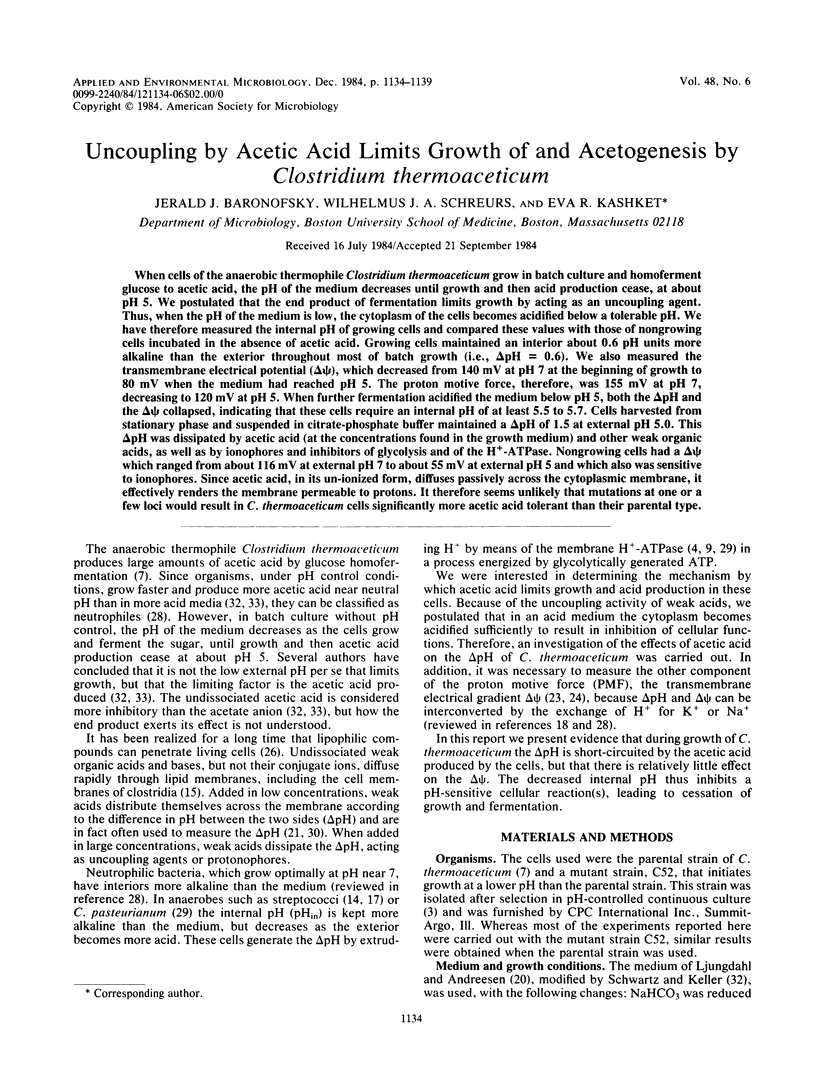

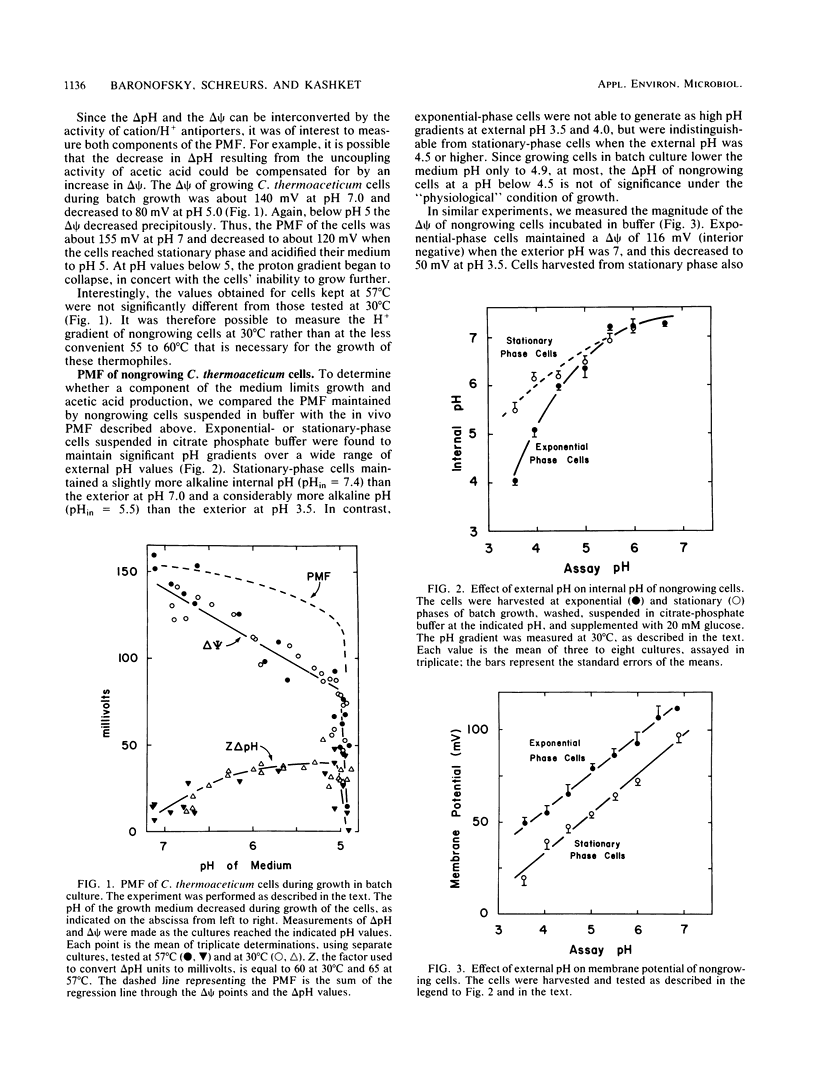
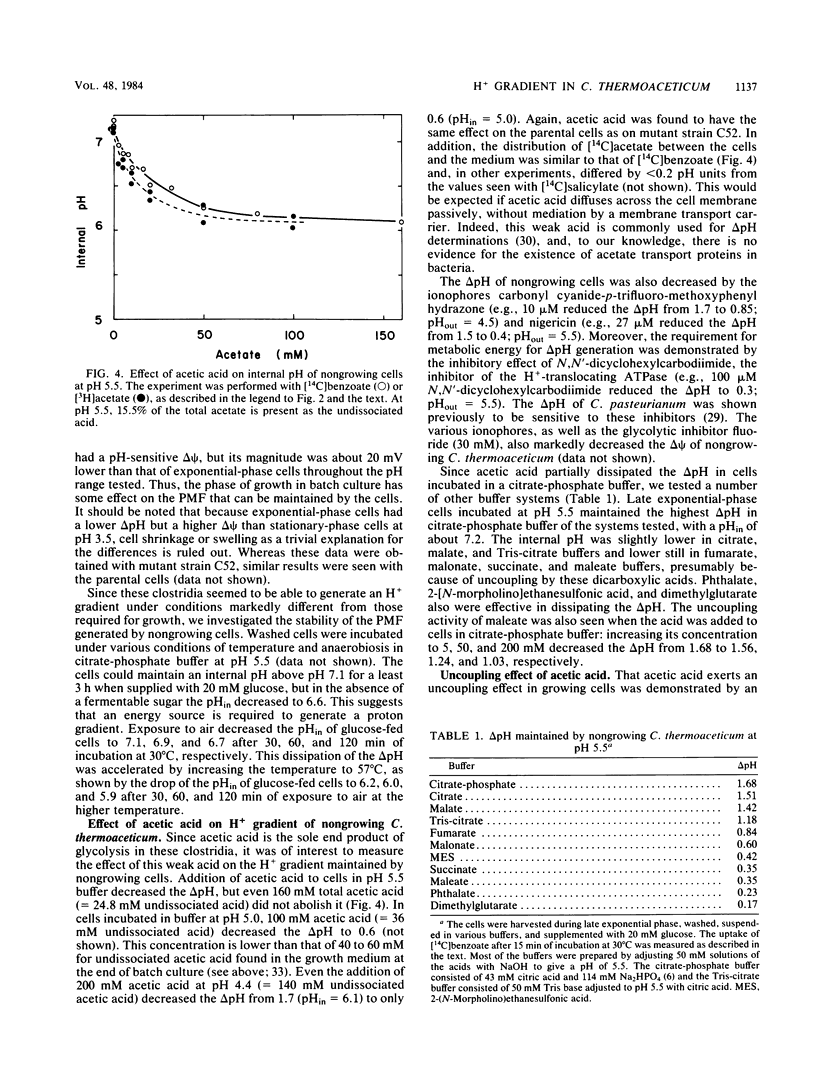
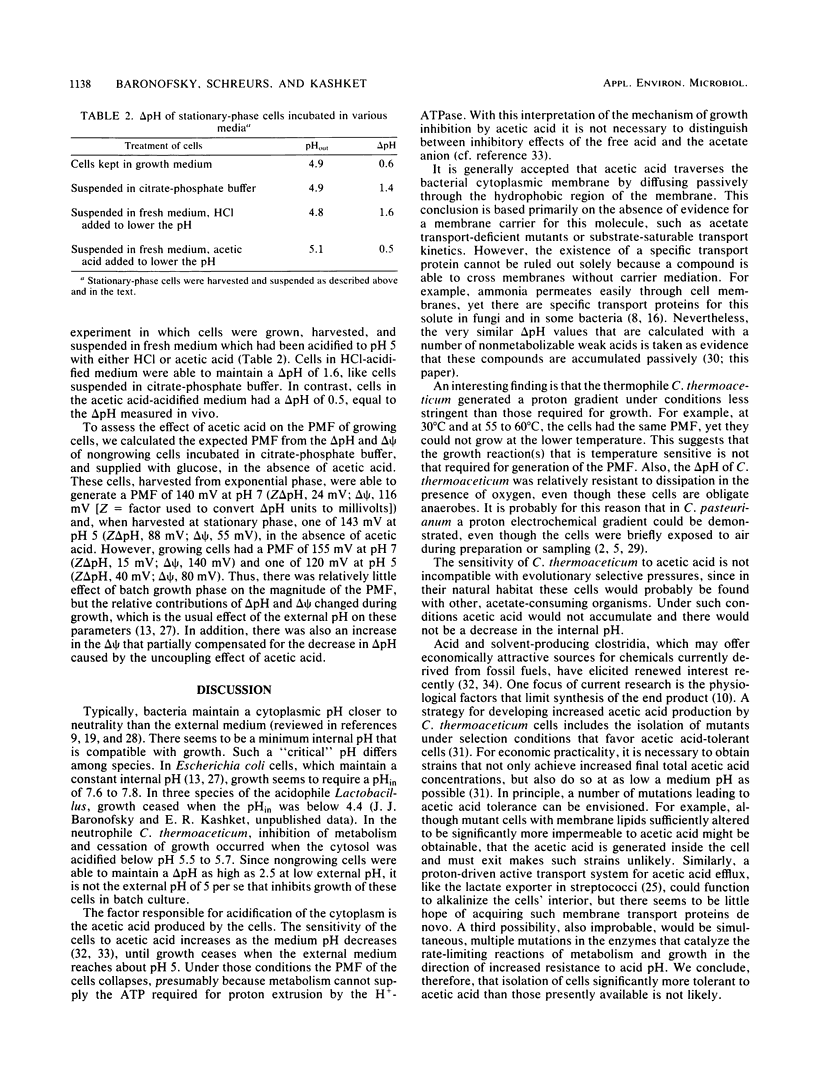
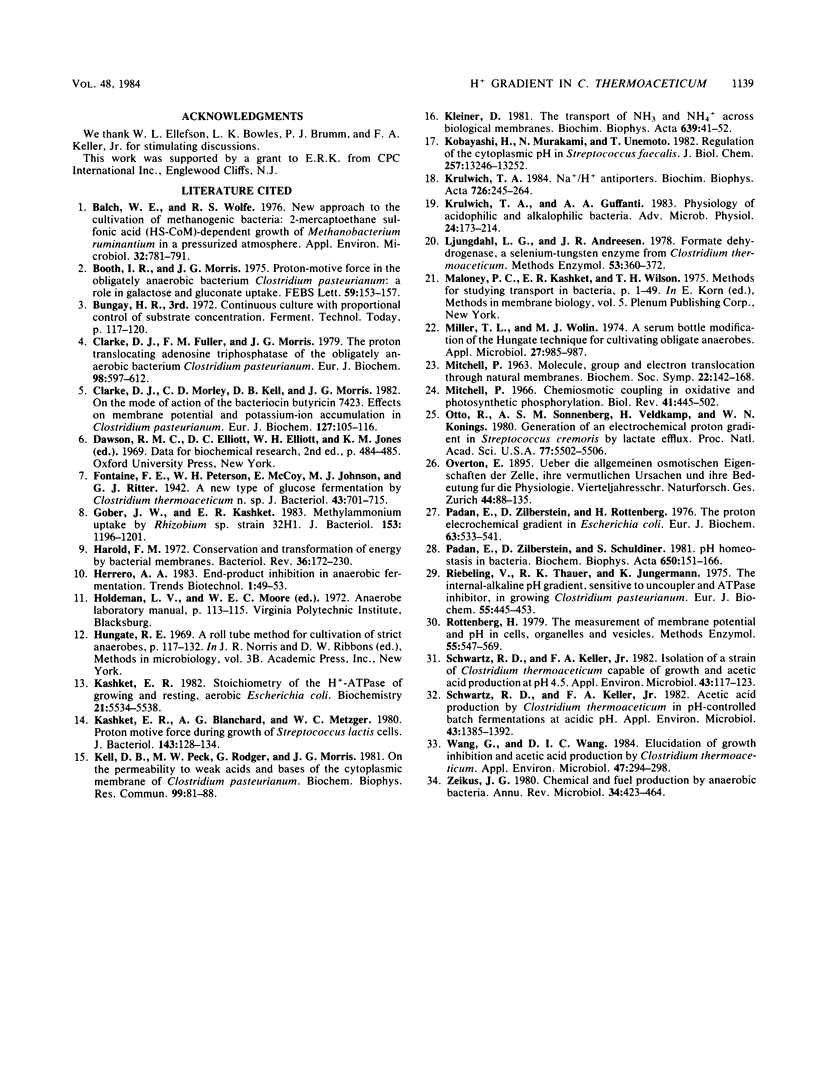
Selected References
These references are in PubMed. This may not be the complete list of references from this article.
- Balch W. E., Wolfe R. S. New approach to the cultivation of methanogenic bacteria: 2-mercaptoethanesulfonic acid (HS-CoM)-dependent growth of Methanobacterium ruminantium in a pressureized atmosphere. Appl Environ Microbiol. 1976 Dec;32(6):781–791. doi: 10.1128/aem.32.6.781-791.1976. [DOI] [PMC free article] [PubMed] [Google Scholar]
- Booth I. R., Morris J. G. Proton-motive force in the obligately anaerobic bacterium Clostridium pasteurianum: a role in galactose and gluconate uptake. FEBS Lett. 1975 Nov 15;59(2):153–157. doi: 10.1016/0014-5793(75)80364-4. [DOI] [PubMed] [Google Scholar]
- Clarke D. J., Fuller F. M., Morris J. G. The proton-translocating adenosine triphosphatase of the obligately anaerobic bacterium Clostridium pasteurianum. 1. ATP phosphohydrolase activity. Eur J Biochem. 1979 Aug 1;98(2):597–612. doi: 10.1111/j.1432-1033.1979.tb13222.x. [DOI] [PubMed] [Google Scholar]
- Clarke D. J., Morley C. D., Kell D. B., Morris J. G. On the mode of action of the bacteriocin butyricin 7423. Effects on membrane potential and potassium-ion accumulation in Clostridium pasteurianum. Eur J Biochem. 1982 Sep;127(1):105–116. doi: 10.1111/j.1432-1033.1982.tb06843.x. [DOI] [PubMed] [Google Scholar]
- Fontaine F. E., Peterson W. H., McCoy E., Johnson M. J., Ritter G. J. A New Type of Glucose Fermentation by Clostridium thermoaceticum. J Bacteriol. 1942 Jun;43(6):701–715. doi: 10.1128/jb.43.6.701-715.1942. [DOI] [PMC free article] [PubMed] [Google Scholar]
- Gober J. W., Kashket E. R. Methylammonium uptake by Rhizobium sp. strain 32H1. J Bacteriol. 1983 Mar;153(3):1196–1201. doi: 10.1128/jb.153.3.1196-1201.1983. [DOI] [PMC free article] [PubMed] [Google Scholar]
- Harold F. M. Conservation and transformation of energy by bacterial membranes. Bacteriol Rev. 1972 Jun;36(2):172–230. doi: 10.1128/br.36.2.172-230.1972. [DOI] [PMC free article] [PubMed] [Google Scholar]
- Kashket E. R., Blanchard A. G., Metzger W. C. Proton motive force during growth of Streptococcus lactis cells. J Bacteriol. 1980 Jul;143(1):128–134. doi: 10.1128/jb.143.1.128-134.1980. [DOI] [PMC free article] [PubMed] [Google Scholar]
- Kashket E. R. Stoichiometry of the H+-ATPase of growing and resting, aerobic Escherichia coli. Biochemistry. 1982 Oct 26;21(22):5534–5538. doi: 10.1021/bi00265a024. [DOI] [PubMed] [Google Scholar]
- Kell D. B., Peck M. W., Rodger G., Morris J. G. On the permeability to weak acids and bases of the cytoplasmic membrane of Clostridium pasteurianum. Biochem Biophys Res Commun. 1981 Mar 16;99(1):81–88. doi: 10.1016/0006-291x(81)91715-0. [DOI] [PubMed] [Google Scholar]
- Kleiner D. The transport of NH3 and NH4+ across biological membranes. Biochim Biophys Acta. 1981 Nov 9;639(1):41–52. doi: 10.1016/0304-4173(81)90004-5. [DOI] [PubMed] [Google Scholar]
- Kobayashi H., Murakami N., Unemoto T. Regulation of the cytoplasmic pH in Streptococcus faecalis. J Biol Chem. 1982 Nov 25;257(22):13246–13252. [PubMed] [Google Scholar]
- Krulwich T. A., Guffanti A. A. Physiology of acidophilic and alkalophilic bacteria. Adv Microb Physiol. 1983;24:173–214. doi: 10.1016/s0065-2911(08)60386-0. [DOI] [PubMed] [Google Scholar]
- Krulwich T. A. Na+/H+ antiporters. Biochim Biophys Acta. 1983 Dec 30;726(4):245–264. doi: 10.1016/0304-4173(83)90011-3. [DOI] [PubMed] [Google Scholar]
- Ljungdahl L. G., Andreesen J. R. Formate dehydrogenase, a selenium--tungsten enzyme from Clostridium thermoaceticum. Methods Enzymol. 1978;53:360–372. doi: 10.1016/s0076-6879(78)53042-5. [DOI] [PubMed] [Google Scholar]
- Miller T. L., Wolin M. J. A serum bottle modification of the Hungate technique for cultivating obligate anaerobes. Appl Microbiol. 1974 May;27(5):985–987. doi: 10.1128/am.27.5.985-987.1974. [DOI] [PMC free article] [PubMed] [Google Scholar]
- Mitchell P. Chemiosmotic coupling in oxidative and photosynthetic phosphorylation. Biol Rev Camb Philos Soc. 1966 Aug;41(3):445–502. doi: 10.1111/j.1469-185x.1966.tb01501.x. [DOI] [PubMed] [Google Scholar]
- Otto R., Sonnenberg A. S., Veldkamp H., Konings W. N. Generation of an electrochemical proton gradient in Streptococcus cremoris by lactate efflux. Proc Natl Acad Sci U S A. 1980 Sep;77(9):5502–5506. doi: 10.1073/pnas.77.9.5502. [DOI] [PMC free article] [PubMed] [Google Scholar]
- Padan E., Zilberstein D., Rottenberg H. The proton electrochemical gradient in Escherichia coli cells. Eur J Biochem. 1976 Apr 1;63(2):533–541. doi: 10.1111/j.1432-1033.1976.tb10257.x. [DOI] [PubMed] [Google Scholar]
- Padan E., Zilberstein D., Schuldiner S. pH homeostasis in bacteria. Biochim Biophys Acta. 1981 Dec;650(2-3):151–166. doi: 10.1016/0304-4157(81)90004-6. [DOI] [PubMed] [Google Scholar]
- Riebeling V., Thauer R. K., Jungermann K. The internal-alkaline pH gradient, sensitive to uncoupler and ATPase inhibitor, in growing Clostridium pasteurianum. Eur J Biochem. 1975 Jul 1;55(2):445–453. doi: 10.1111/j.1432-1033.1975.tb02181.x. [DOI] [PubMed] [Google Scholar]
- Rottenberg H. The measurement of membrane potential and deltapH in cells, organelles, and vesicles. Methods Enzymol. 1979;55:547–569. doi: 10.1016/0076-6879(79)55066-6. [DOI] [PubMed] [Google Scholar]
- Schwartz R. D., Keller F. A. Acetic Acid Production by Clostridium thermoaceticum in pH-Controlled Batch Fermentations at Acidic pH. Appl Environ Microbiol. 1982 Jun;43(6):1385–1392. doi: 10.1128/aem.43.6.1385-1392.1982. [DOI] [PMC free article] [PubMed] [Google Scholar]
- Schwartz R. D., Keller F. A. Isolation of a Strain of Clostridium thermoaceticum Capable of Growth and Acetic Acid Production at pH 4.5. Appl Environ Microbiol. 1982 Jan;43(1):117–123. doi: 10.1128/aem.43.1.117-123.1982. [DOI] [PMC free article] [PubMed] [Google Scholar]
- Wang G., Wang D. I. Elucidation of Growth Inhibition and Acetic Acid Production by Clostridium thermoaceticum. Appl Environ Microbiol. 1984 Feb;47(2):294–298. doi: 10.1128/aem.47.2.294-298.1984. [DOI] [PMC free article] [PubMed] [Google Scholar]
- Zeikus J. G. Chemical and fuel production by anaerobic bacteria. Annu Rev Microbiol. 1980;34:423–464. doi: 10.1146/annurev.mi.34.100180.002231. [DOI] [PubMed] [Google Scholar]


